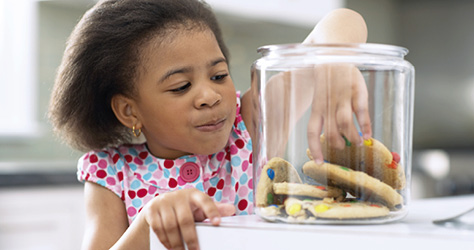What's safe and how you can reduce your child's intake.
It’s so easy to feed your toddler too much sugar and salt without realising it. Here’s what they should be eating, and how to cut down.
At a glance
- How much salt and sugar should your little one be eating
- Hidden sugars
- Tips for cutting down

Sugar
We’re all eating way more sugar than we think – especially our kids. The World Health Organisation says sugar should make up no more than 5% of our daily diet. But in the UK, that figure is 11.6% for adults and a massive 15.2% for children.
So it makes sense to be really careful about our little ones’ sugar intake right from the moment they’re weaned. The toddler years are really important because that’s when their future eating patterns are established.
Sugar damages our teeth, and eating too much also makes kids overweight and puts them at risk of high blood pressure, diabetes and heart disease in later life.
The trouble is, a lot of the sugar we eat is hidden in the food we buy – even in savoury food. And one study found that foods specially aimed at children, like yoghurts, breakfast cereals and ready meals, were some of the sweetest of all.
For example, did you know that:
-
A glass of orange or apple juice contains as much sugar as cola. That’s six teaspoons in a 250ml glass
-
Dried fruit like raisins are almost all sugar
-
Shop-bought pizzas can be high in sugar: some have 1-2 teaspoons per 100g
-
Children’s yoghurts and fromage frais can contain three teaspoons of sugar in a standard 100g pot (one and a half teaspoons in a small 50g pot)
-
Jars of pasta sauces can contain one and a half teaspoons of sugar in a small portion
-
Children’s breakfast cereals can by sky-high in sugar – even the healthy-sounding ones can have three teaspoons of sugar per small 30g bowl
-
One squirt of ketchup contains over one teaspoon of sugar
The Government’s ‘five-a-day’ advice on fruit and vegetables can also mean our kids are accidentally eating too much sugar. As mums, we know our little ones often struggle to eat enough vegetables, but love fruit because it’s sweet. So it’s easy to let them have lots of juice, fruit and dried fruits. These are fine in moderation, but we’re probably all eating too much.
Tips for cutting down on sugar
-
Have lots of savoury snacks at the ready. Substitute cereal/dried fruit bars, sweet yoghurts, biscuits and cake for whole fruit, veg sticks and hummus, unflavoured popcorn, toast fingers and cheese
-
Give them one or two portions of fruit a day, but try to offer the lowest-sugar fruits: that’s berries (strawberries, blueberries, raspberries), peaches, pears and kiwis. The highest sugar fruits are grapes, melon, pineapple and sweet apple varieties
-
Go for whole fruits rather than juice as the whole fruit contains fibre to tone down the effect of the sugar hit on your child’s body
-
If you do give juice, dilute it and offer at mealtimes rather than as a snack to protect their teeth. Don’t give them fizzy drinks until they’re older, and then only occasionally
-
Cook from scratch where you can, especially easy dishes like pasta sauces, as you won’t be adding any sugar. Save high-sugar processed foods for occasional treats
-
Keep an eye on food labels. Sugar is often called other names on the ingredients list. For example: concentrated fruit juice, fructose, golden syrup, inverted sugar syrup, molasses, and sucrose
Salt
You’ll already know not to add salt to your baby’s food, as babies under one should have no more than 1g a day. Their tiny kidneys can’t cope with it. But even when they’ve turned one, we still have to be careful not to add salt.
From aged one to three the Government advises a maximum of 2g a day (3g for kids aged 4-6). But because salt is added to so many of the foods we buy, it’s easy accidentally to eat too much.
Salt is added to breakfast cereals (although the amount has been cut in recent years), ready made soups, sauces and ketchup. If the label says ‘sodium’ you have to multiply by 2.5 to get the amount of salt.
Tips for cutting down on salt:
- Go easy on ham and processed meats, including sausages, which are high in salt. Opt for fish or chicken instead
- Don’t salt the pasta water – they don’t need it and if you can stop them developing a taste for salt, it will benefit their health later. High salt intake causes high blood pressure and increases the risk of heart disease and stroke in middle age
- Keep processed food like pizza and fish fingers for an occasional treat
- Don’t add salt at the table
- Even biscuits contain salt: digestives are particularly high at 0.2g per biscuit
- Go easy on bought sauces and gravies as they are often high in salt
- Go for low-salt options where you can, like baked beans and ketchup. They’ll never know the difference
- Supermarket own-brand breads, cereals and sauces are often lower in salt than branded products. Check the labels (or online) to find the lowest. If your kids are brand loyal, put the product in a squeezy bottle or plastic pouring box
- With staple foods like bread it’s really worth shopping around to find the lowest salt version you can – changing brands could mean you save 0.4g of salt a day on four slices of bread, and no one will ever know!